Sun creams - Sun protection
The sun's rays, a source of life but also a source of danger
Solar radiation
The sun emits a range of light rays that reach the earth's surface: ultraviolet (UV), visible and infrared (IR).
UV rays as a whole do not exceed 5% of total energy, but their impact on organic molecules is very significant, leading to considerable physiological responses in all areas of life.
UVA, UVB and UVC have different wavelength ranges. The energy of each type of radiation depends on its light source (the sun, for example) and the medium in which it is propagated (the earth's atmosphere if the source is the sun).
What are the differences between UVA, UVB and UVC ?
- UVA solar radiation :
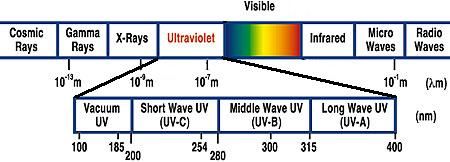
UVA rays penetrate glass. Their wavelengths are between 320 and 400 nm. A distinction is made between short-wave UVA (or WA 2) between 320 and 340 nm and long-wave WA (or UVA 1) between 340 and 400 nm. Of the UV rays that reach the earth, 98% are UVA.
Less energetic than UVB, they have a greater capacity to penetrate the skin and 20-30% reach the middle dermis.
UVA rays stimulate the synthesis of melanin: this is known as "UVA tanning" or delayed pigmentation.
UVA rays are not directly toxic, but their radiation generates the production of free radicals, extremely reactive molecules with a short life span. These free radicals initiate chain reactions that alter DNA, proteins and lipids, leading to the formation of cancerous cells. The incidence of UVA in certain epidermal tumours (epileptoid carcinoma) has been clearly established. UVA is also considered to be a factor that increases the risk of melanoma. Molecular alterations induced by UVA are also at the root of premature ageing of the skin, particularly the structures of the dermis. The soluble collagen/insoluble collagen ratio decreases to the point where the skin's mechanical properties (elasticity, thickness, etc.) vary. When these skin changes are accompanied by thinning of the epidermis, the appearance of wrinkles and pigmentation spots, all these changes are grouped together under the term "solar elastosis". - UVB solar radiation :
UVB rays are responsible for solar erythema (sunburn), which reaches its peak intensity 24 hours after exposure. This reaction stimulates the skin's melanogenesis process, which is responsible for delayed pigmentation, a process also largely attributed to UVA rays.
Their high energy can cause necrosis of epidermal cells. These damaged cells are known as sunburn cells and release chemical mediators that contribute to the inflammatory effects of sunburn. The high energy content of UVB rays also enables them to generate molecular disorders (alteration of certain DNA and protein bonds) which, in the long term and if renewed, saturate the DNA repair system. This leads to 'errors' in the genome of the affected cells, which can cause skin cancer. This is why we speak of direct UVB toxicity. - UVC solar radiation :
UVC corresponds to the fraction of UV rays that is only transmitted through the air. UVC radiation has the shortest wavelengths (190 to 290 nm) and is therefore extremely energetic.
This energy gives them considerable power to alter biological molecules. They are used for their germicidal activity in hospitals. Since one of their targets is DNA, they have a very high carcinogenic potential.
If all the UVC generated by the sun reached the earth's surface, the toxicity they would cause would be such that life would be impossible.
Solar radiation is not constant
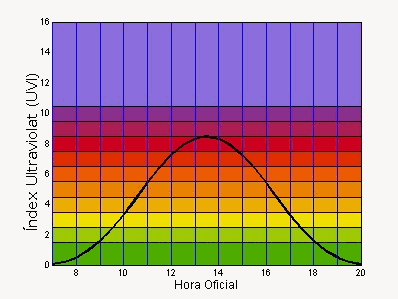 The quality of radiation on the earth's surface is not constant. UV intensity increases as :
The quality of radiation on the earth's surface is not constant. UV intensity increases as :
- you get closer to the equator and the altitude increases: at 1500 m, there is 20% more UVB than at sea level.
- you are exposed between 12 and 16 legal sunlight hours (10 and 14 solar hours): 50% of the day's UV energy is delivered during this period.
- Ground reflection increases: it is 10% for seawater, 15-25% for sand and 50-85% for snow.
Appropriate sun protection from childhood
The carcinogenic power of UV rays is clearly established for cancers of the epidermal part of the skin: these are squamous cell carcinomas and squamous cell carcinomas. As for cancers affecting the dermis, it has been shown that some malignant melanomas occur ten to twenty years after a childhood sunburn.
The sun sensitivity (phototype) of children and teenagers needs to be assessed. A fair-skinned person, for example, will never have a protective tan. Under the action of UV rays, their skin preferentially produces a red pigment that not only fails to protect, but also releases free radicals that are toxic to the skin. This damage is often the result of over-exposure in the first few years of life.
This is why appropriate photoprotection, introduced from childhood, considerably reduces the risk of skin cancer.
Source : https://www.pediatre-online.fr/
Sun protection and skin cancer
A reminder of the basic recommendations: cover up, seek shade, don't brave the midday sun and always, always use sun protection.
Otherwise, we're told, we'll have to face the consequences of premature ageing of our skin: early wrinkles and the risk of developing skin cancer.
Contrary to what is said, application every 2-3 hours, research has shown that the best protection is provided by application 15-30 minutes before exposure, followed by a further application 15-30 minutes after exposure to the sun. The application should then be repeated every 2 hours. Reapplication is also necessary after activities such as swimming.
It does not kill as often as other cancers, such as lung and breast cancer, but it nevertheless killed 1,570 people in France in 2010, according to the French National Cancer Institute.
Cases of skin cancer have tripled in the last 20 years, despite the fact that very few of us use sun creams. You'd think that the public health mission would be to convince as many people as possible to protect themselves with sun cream.
But the curious thing is that the rate of skin cancer and the use of sun cream have both increased simultaneously.
Sun creams can cause more problems than benefits
Today, most sun creams are 'broad spectrum', meaning that they protect against ultraviolet A (UVA) and ultraviolet B (UVB) rays.
UVA and UVB rays pass through clouds and are responsible for premature ageing of the skin. For some years now, this premature ageing has been associated with sunburn.
UVB is known as the "killer ray" because it causes solar erythema.
You might think that we don't use products properly, and that we spend more time outdoors.
You might also think that, since skin cancer takes years to develop, it's too early to draw any conclusions.
The increase in the use of sun protection and the increase in skin cancer could be seen as a paradox. But some scientists have long feared that the chemicals commonly used in sun creams could cause more trouble than good.
Can sunscreens cause DNA damage ?
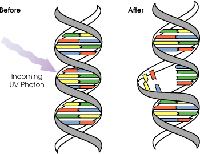
The sun protection products we use today are either chemical or physical sunscreens.
Dr Stephen Antczak, co-author of Cosmetics Unmasked, explains the difference: "Physical sunscreens contain materials that reflect ultraviolet rays. Chemical sunscreens contain molecules that absorb ultraviolet rays and reduce their energy".
These chemicals, which can modify ultraviolet rays, are both complex and powerful.
The three molecules most commonly used in sunscreens are: para-aminobenzoic acid, cinnamates and benzophenones.
A sun cream that absorbs energy cannot destroy it. Dr John Knowland, a biochemist at Oxford University, is concerned about absorbing sunscreens: "UV rays react with light and therefore interfere with the skin, causing DNA damage - one of the possible causes of cancer".
Do sun creams penetrate our skin ?
There are reports that the chemicals used in sun protection, rather like nicotine in patches, can penetrate the skin.
Kim Erickson, author of "Protecting yourself from the hidden dangers of cosmetics", cites a study from the Queensland Laboratory in Australia, where the chemical sunscreen oxybenzone penetrated the skin's protective barrier.
Scientists at Sahlgrenska University in Sweden showed that benzophenone-3 (B-3), another UV-absorbing chemical, appeared in the urine of volunteers who had applied the recommended amount of sunscreen, in some cases up to 48 hours later.
In Switzerland, researchers carried out five tests with chemicals commonly used in sun creams. They found that these products all acted like oestrogen. One of the chemicals tested was found in breast milk.
The Women's Environmental Network suggests that "these substances are not only absorbed through our skin but accumulate in our fatty tissue".
The researchers above call for caution and more research.
Does sun cream work as a defence ?
Although manufacturers don't say so, there is a popular misconception that sun creams protect against skin cancer.
Sun creams have been tested on laboratory rats to protect against squamous cell cancer.
Squamous cell cancer is one of three types of skin cancer. It occurs more frequently than melanoma (which is potentially fatal), but much less frequently than basal cell cancer, which is the most widespread. There was insufficient evidence to conclude that sunscreen was useful in protecting against squamous cell cancer.
According to a WHO research group comprising scientists, doctors and sunscreen manufacturers, "no conclusion can be drawn regarding the use of sunscreen against basal cell carcinoma and cutaneous melanoma".
Exposure to UV rays, even with sun cream, is likely to be a risk factor.
Dermatologists advise that sunburn increases susceptibility to skin cancer.
Sun protection products aren't everything, genes matter too
"The biggest problem with skin cancer is your genes," says dermatology professor Gasparro "Some people may be able to stay in the sun longer than others - but you can't give this as a public health message."
The idea is to pass on simple information, taking into account all the messages and following dermatologists' recommendations on the use of sun creams.
However, in recent years, dermatologists and cancer research groups have downgraded sun protection as a defence to third place - for those occasions when you absolutely cannot cover up or avoid going out in the sun.
Melanin and sun protection
Melanins are among the main biological pigments responsible for skin colour in humans.
Melanins are what make us tan, protecting the DNA of skin cells from the sun's ultraviolet (especially UVB) rays.
With prolonged exposure to the sun, we tan because the body produces more melanin, so we are better protected against UV rays.
Melanins act by absorbing UV rays and releasing the energy received in the form of heat.
Eumelanin (dark pigment) is much more effective in this role than pheomelanin (light pigment), which offers very little protection and breaks down easily under the effect of UV rays, releasing carcinogenic free radicals. This is why redheads are more fragile than brunettes. Blondes are also very sensitive to the sun.
Even for dark skins, the protection offered by melanin is far from total.
Excessive DNA damage can lead to skin cell carcinogenesis.
Sun Protection Factor (SPF)
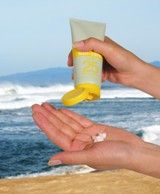
Franz Greiter defined the concept of sun protection factor (SPF) in 1962. It has become a worldwide standard for measuring the effectiveness of a sun cream when applied at a minimum rate of 2 milligrams per square centimetre. You'll also find it on bottles under the name SPF for "Sun protector factor".
SPF is a laboratory measurement. The higher the SPF, the greater the protection against UV-B (ultraviolet radiation that causes sunburn).
So, with an SPF 50 sun cream, your skin won't burn until it has been exposed to 50 times the amount of solar energy that would normally cause it to burn.
The amount of solar energy you are exposed to depends not only on how long you are in the sun, but also on the time of day. The sun's rays are weaker in the morning and evening than at midday.
In practice, the protection provided by a sun cream depends on several factors :
- the user's skin type
- the quantity and frequency of application,
- their activity (swimming, for example, causes sun cream to be lost from the skin),
- the amount of sunscreen absorbed by the skin.
The PFS is an incomplete measure because invisible damage and ageing of the skin are also caused by ultraviolet A (UVA, wavelength 320 to 400 nm), which does not cause redness or pain.
According to a 2004 study, UVA also causes DNA damage to cells deep within the skin, increasing the risk of malignant melanoma.
Even some 'broad spectrum UVA/UVB' sun creams do not provide sufficient protection against UVA rays.
Sun protection against UVA

The best protection against UVA is provided by products containing zinc oxide, avobenzone, ecamsule or titanium dioxide. The latter probably gives good protection, but does not completely cover the entire UV-A spectrum. According to recent research, zinc oxide provides better protection than titanium dioxide in the wavelengths between 340 and 380 nm.
According to Professor Knowland, from Oxford University, "if such particles can more easily penetrate human cells, the issue has not yet been sufficiently addressed".
With regard to titanium oxide, the European Commission's Scientific Advisory Committee on Cosmetics advises that the compound is "compliant with regulations and safe for use in cosmetic products".
The different phototypes
PHOTOTYPE 1 : You have very fair skin, white (albino) or red hair and freckles that appear very quickly when exposed to the sun.
- Never try to tan, protect yourself from the sun in all circumstances (clothes, hats, glasses...)
- Protective cream: sunscreen
PHOTOTYPE 2 : You have very fair skin that can become tanned, blond or light brown hair and freckles that appear in the sun.
- Don't try to tan. You should use maximum protection and expose yourself to the sun as little as possible
- Protective cream : a screen with an index greater than 30
PHOTOTYPE 3 : You have fair skin that tans easily, blond or chestnut hair and few or no freckles.
- You can expose yourself to the sun, but gradually and to a limited extent.
- Protective cream : sunscreen with an index greater than 15
PHOTOTYPE 4 : You have matt skin that tans very easily, chestnut or brown hair and no freckles.
- You can expose yourself gradually
- Protective cream: a screen with an index greater than 10 for the first few days.
PHOTOTYPE 5 ou 6 : You have naturally pigmented skin or black skin.
- You can expose yourself gradually
- Moisturising cream
Is SPF still appropriate for sun creams ?
The minimum application according to the definition of SPF is 2 milligrams per square centimetre of skin to be protected. A quick calculation shows that for an average-sized adult, a minimum of 30g of sun cream should be used per application.
Unfortunately, "this information is useless, because people rarely use that much", according to Professor Brian Diffey, Director of Clinical Services at Newcastle General Hospital.
He suggests that manufacturers reduce the amount of sunscreen used in tests to reflect what people actually use.
But if the standard is to evolve, it should be done at the same time in all countries. Without this harmonisation of the standard, consumers would be confused.
Sun cream and vitamin D deficiency
UV rays are responsible for the synthesis of vitamin D. The use of sun cream reduces the skin's capacity to synthesise vitamin D. This can lead to vitamin D deficiency.
To avoid this, here are the recommendations of Professor Holick, one of the world's leading vitamin D specialists:
"I recommend that people expose themselves for a length of time that varies according to the time of year, the time of day, the latitude and the degree of skin pigmentation. If you know that after 30 minutes' exposure you get a slight sunburn, I recommend 10 to 15 minutes' exposure of the arms and legs, or the abdomen and back if you're in a swimming costume, 2 or 3 times a week. You need to wear sun protection on your face, which is the most sensitive area. Go outside, expose yourself to the sun and then, if you plan to be out in the sun for longer, put on sunscreen."
True / False about the sun and skin cancer
Sunburn is the first stage in tanning : FALSE
In all cases, a sunburn is already a skin lesion. As well as causing pain, "light" sunburns cause the skin to thicken. If the sunburn is more serious (burning, blistering), the skin "peels" and leaves room for new, more fragile tissue, which is likely to burn in turn... It's a vicious circle !
You tan better with a low SPF product : TRUE
If your skin is suitable for tanning. But you run the risk of getting sunburnt more easily. Sunburn doesn't happen as quickly to dark-skinned people, but it does happen... and the skin is damaged.
Everyone can tan, you just have to give it enough : FALSE
Some people, such as redheads, produce little or no of the brown pigments needed for tanning.
The sun helps in the treatment of certain illnesses : TRUE and FALSE
TRUE for :
- Rickets (but 10 minutes' exposure a day is enough)
- Psoriasis (in combination with other treatments)
- Eczema
FALSE for :
- Acne
- Joint pain (it's better to treat the cause), even if the heat helps
You need to keep an eye on all moles : TRUE
The term "mole" refers to several types of pigmented lesion on the skin: warts, papillomas, nevi, etc. Only lesions containing cells that produce melanin pigment, known as "melanocytic nevi", can cause skin cancer. But if in doubt, a 'mole' that changes appearance, bleeds, spreads or changes colour should be checked by your doctor.
Our organic suncare range
Our range of suncare products is ideal for people looking for effective protection, pleasant galenic formulations (easy to apply, pleasant fragrances, etc.) and total safety of the ingredients in the formulas.
FOR BABIES
FOR CHILDREN
FOR ADULTS
FOR THE WHOLE FAMILY
All our sun protection products
source : https://www.lanutrition.fr / www.ligue-cancer.net










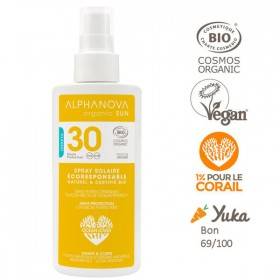
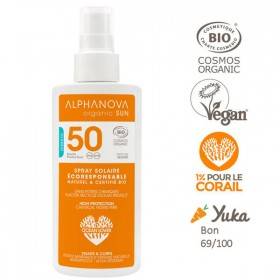
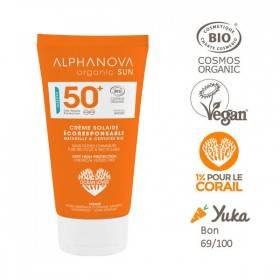
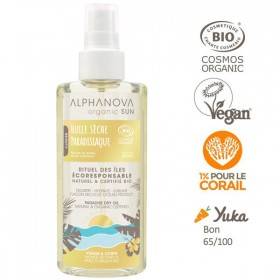
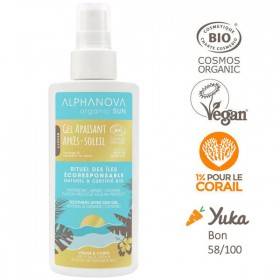
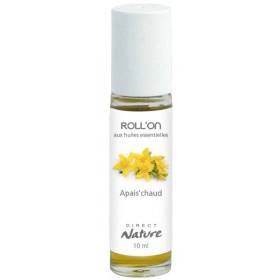
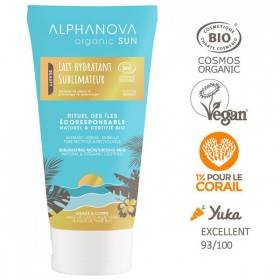
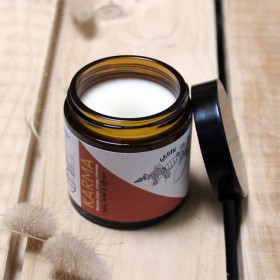
Customer reviews
Efficacité de la livraison , très rapide . Produits livres en parfait état . Très bien emballés . Merci.
Geneviève
Site internet complet, beau et facile d'utilisation<br /> Commande complète et correcte.<br /> Commande emballée a la perfection avec du matériel recyclable, compostable<br /> Délai d'envoi respecté même a l'étranger (Pays-Bas)<br /> Mention spécial pour le petit mot personnalisé ++<br /> On sait pourquoi on commande chez Penntybio depuis 10ans :)<br /> Bonne continuation
Jennifer A.
Livraison rapide et avec colis préparé avec soin :)
Florian
Hélène
Les produits commandés sont conformes à mes attentes. Quant à l'accueil au téléphone, il est parfait et nous avons toujours trouvé un terrain d'entente. Je fais confiance à Penntybio.<br /> Merci.
XX
Livraison ultra rapide, bien emballée. Produits au top. Parfait !
Caty
Je parlerais de vous a mes amies car vos produits sont vraiment excellents. Bien a vous et tous mes remerciements.
Patricia
Personne disponible, de très bon conseil suite à des punaises de lits dans mon habitation, les produits sont efficaces car depuis aucune punaises et la vie à repris son cours ... merci pour tout
Nathalie
Service très professionnel et très rapide. A conseiller fortement.
Didier M.
Parfait. Rien à redire. Extrêmement efficace.
Quentin
En cette période d'avant Noël, je craignais que me colis arriverais en retard. 48h après mon achat, c'était dans la boîte aux lettres. Du coup, je suis large pour mettre mon achat sous le sapin. Merci à vous
Art4
Cliente fidèle depuis plusieurs années, je ne peut que recommander ce site. Tout est parfait. Tous les produits au top, rapidité d’envoi, gentillesse, allez y les yeux fermés vous ne serez jamais déçus.
Marité 06
Livraison rapide, emballage plus que parfait, le diffuseur NEOLIA est merveilleux pas bruyant, fonctionnement idéal. Merci PENNTYBIO pour votre sérieux, site web à recommander.
CLAUDE
Commande reçu en 2 jours, impeccable. Tous les produits emballés avec le plus grand soin, petit mot personnalisé! Et encore un petit savon bio au parfum délicieux comme cadeau!! Merci Penn'Ty Bio !!
Orchidée
Les produits achetés sont excellents. Ils répondent parfaitement à ce que je cherchais. Bravo pour votre site
Michel
Ma commande s'est déroulée sans aucun problème avec une livraison rapide et soignée. La satisfaction est au rendez-vs ! Continuez ainsi ! Merci et cordialement !
Etoile 07
J'ai bien reçu ce jour, en bon état, les 2 diffuseurs galets. Merci aussi pour votre petit mot manuscrit me souhaitant un bel été. Fidèlement,
Annie
Toujours aussi "réactif" et efficace<br /> Bravo et merci pour votre professionnalisme.
Annick P.
J'apprécie les services de Penn'ty bio. Un maximum d'étoiles pour eux.
Ch. D.
Site très sérieux et personnel vraiment agréable. Envoi rapide. C est parfait !
Ingrid
J’ai bien reçu le nouveau diffuseur fonctionnel après essai et je vous remercie pour votre confiance et votre rapidité sur le traitement de mon problème. Ce n’est pas tous les jours que l’on voit un SAV aussi efficace !
Florent
Super produits accueil plus que parfait gentillesse. Livraison au top merci beaucoup
Christiane
Très bien !
XX
excellent.
XX
Colis très bien protégé service rapide. Merci. Site très sérieux .
Elios R.
Un grand merci pour cette commande envoyée très rapidement. Je recommanderais votre site
Elise
Bon produit , envoi rapide.<br /> <br /> <br />
Christine
J’ai bien reçu mon colis et vous remercie de votre rapidité. Bravo pour le geste écologique et durable. Emballage nickel ! Et mon chat a adoré jouer avec les billes jaunes !
Anouk
Dommage, les vendeurs ne savent pas lire les indications inscrites sur les produits qu'ils vendent
XX
Bravo pour votre sérieux. Colis reçu très vite et produits impeccables. Belles fêtes de fin d'année
Mat
Totalement satisfait. Les produits sont super efficaces et tout est très bien suivis. Je recommande vivement ce site.
Stéphane N.
Site sérieux. Bons produits.
Magali
Livraison express. Colis toujours aussi bien préparé (cales, flocons, adhésif sur les bouchons qui risquent de couler). Bravo pour votre professionnalisme.
Isabelle
Produits utilisés depuis très longtemps, toujours la même qualité ! Je recommande, les délais de livraison sont très courts, produits très efficaces.
Laurence
Je me permets de vous écrire un petit mot afin de vous dire que votre site est très bien fait.
Tom
Diffuseurs qui sortent vraiment de l'ordinaire, un envoi parfait - merci BCP
Anthony
super contente, j'y trouve facilement les produits dont j'ai besoin et le service est impeccable et gentil !
Hélène S.
Livraison conforme et rapide. Les produits sont emballés dans des emballages recyclables, voire compostables : j'ai beaucoup apprécié. Je recommande ce site.
Patrick
Merci. Je tenais à vous faire part de ma grande satisfaction. Je suis enchantée par les produits et par le service. Salutations et bonne continuation,
Odile
Excellents services, très serviable
XX
Livraison très rapide. Bravo pour la réactivité
François
J'adore. Très grande diversité de produits, les explications sont simples et complètes.Quand aux colis, ils sont extrèmement bien protéger. Un grand merci.
Nadine
Très rapide pour la livraison en Belgique et sérieux. Merci<br />
Corinne
Commande bien reçue;je suis tout à fait satisfaite;à bientôt
Sonia
Produits facile à utiliser, efficaces et finalement pas plus onéreux, à l'usage que des produits issus de la pétrochimie. Service livraison impeccable. Je recommande +++<br />
XX
Site de grande qualité !
Rose Anne Marie
Bons produits, emballage impeccable, livraison super rapide ! Parfait !
XX
Merci d'être à l'écoute pour notre terre et vos clients. Encore une fois je suis très satisfaite de ma commande. Et mes compagnons à 4 pattes sont ravis de se protéger en bio. Merci pour votre attention manuscrite en fin du bon de commande..
Raymonde julie L.
Commande bien reçue ! Bien emballée ! ! ! Jolis produits ! Merci !
AYH
Rapide, sérieux, très bien emballé, un sans faute.Merci.
L.H.
Envoi rapide. Rien a redire.
Marie France
J'ai bien reçu mes articles et je vous remercie pour la livraison rapide et impeccable !
Françoise
Bon produits et service !
Rose-Marie
Excellent site. Très à l'écoute. Livraison rapide. Problème avec un piège à guêpes un autre m'a été livré très rapidement. Chapeau et très agréable de tomber sur des gens compétents.<br /> Encore merci.
XX
Tout à fait satisfait de la qualité de la livraison ainsi que du produit commandé.
Régis
Client depuis plus de 10ans. Toujours satisfait du matériel propose. Boutique sérieuse prix compétitifs livraisons et suivis rapide.
XX
Vos explications par email ont été très claires et votre diligence dans le traitement de ma commande et de mes demandes est très appréciée.
Henri
Excellent service et livraison rapide. A conseiller pour la santé des animaux (chiens et chats)
MICHEL
Juste ce petit mail pour vous dire que j'ai bien reçu votre colis et que mon patron est enchanté ! Ca embaume les huiles essentielles dans le bureau et... ça ne fait pas de bruit ! Encore un grand merci pour votre gentillesse et votre souplesse commerciale.
Sonia
Site très sérieux, de très bons produits et la livraison est rapide.<br />
Isabelle
Très satisfaite de ma commande chez Penn'ty bio. Site très détaillé, produit reçu rapidement, message manuscrit très sympathique. Je recommande !
XM
j'ai bien reçu la commande et je vous remercie pour votre efficacité.
Margot
Bonjour Monsieur,<br /> Nous nous étions parlés au téléphone il y a quelques années. Bravo pour l'évolution de votre site et vos dossiers instructifs. Vos produits aussi sont très bons. Bonne continuation, bien cordialement.
Marina
Un grand merci pour la qualité et la rapidité de votre réponse.
Simon
Je suis très satisfaite de mon échange avec le service client (personne à l'écoute, de bon conseil). Envoi rapide et soigné, avec un petit mot sympathique de l'équipe, le top!
XX
Livraison rapide et petit mot manuscrit joint au colis, vraiment très sympa! Merci et continuez, vous le méritez.
Jean-Pierre
Excellent site d'achat. Très rapide et que de bons produits.
James
service très efficace à chaque fois que j'ai commandé. aucune mauvaise surprise sur la livraison. je recommande
Agnès
Je voulais juste vous remercier. J ai reçu mon répulsif " lézards" aujourd'hui, un petit mot super gentil joint à ma commande ça fait plaisir. J espère que ça va fonctionner. Bonne journée à vous et merci.
Cynthia
livraison impeccable, produit bien emballé et correspondant au descriptif, excepté pour la surface de diffusion, ma salle principale doit faire 25m2 maximum et ça ne se diffuse pas au-delà.
Pascale
Penn'Ty Bio wonderfully served our family in Switzerland so that we could try the range of Totemsavon products, which are such caring, loving, and consciously manifested creations :)<br /> <br /> By allowing a shipment to Switzerland and elsewhere, I am sure so many more people would be able to benefit from the beautifully selected product portfolio in Penn'Ty Bio and all, together, make a conscious leap by using and demanding a way more purer approach to anything we interact with.<br /> <br /> Thank you so so much Penn'Ty Bio!<br /> <br /> In 8 Love We Heart Trust<br /> <br /> Miguel Ángel
Miguel Ángel
Produit performant et raisonnable au niveau prix. Je recommande
XX
Site intéressant. Je l'ai découvert, en fait. Produits ménager éco-responsable. Bon pour la maison et non agressifs. Merci.
Mydiadao
Une boutique en ligne, sympa et très réactive. On apprécie surtout la livraison express. Pas besoin d'être américain pour livrer dans des délais de champion !<br /> <br />
Daniel de Paris
Une entreprise fiable, efficace, de confiance, chez qui je recommande de faire ses achats.
S.
Produits conformes aux descriptifs. Délai de livraison respecté. Satisfaite du nébuliseur qui est superbe.
VR
Au fil de mes commandes (j'en suis à la 5 ou 6ème) décidément, du sérieux et de l'écoute ! chaque fois que j'ai eu un petit problème: contact immédiat, réponse immédiate, et tir rectifié illico ! Dans le top 5 de mes sites internet !
Vincent
Efficacité redoutable. enchanté.
Robert
Parfait comme d'habitude
Sylvain
Infestés de puces de parquet, le produit a agi en moins de 24 heures. Livrés en tout autant de temps. Le seul produit qui ait fonctionné et en plus archi cool pour la nature.
Nicolas
Rapidité, emballage nickel et écologique, mot de remerciements personnalisé, produits au top....j adore....je suis une nouvelle cliente conquise. Un grand merci...
Hélène P.
Everything was very nice ! Keep handling your customers likes this!
xxx
Marie Aline Roux
On ne peut pas toujours faire confiance à des sites de ventes sur le web, mais sur Penn'Tio, j' y viens les yeux fermés. Excellente communication avec le service clientèle, un suivi sérieux. Je remercie chaleureusement toute l' équipe.
Sergine T.
merci pour votre professionnalisme. Merci pour les produits envoyés dans de bons délais. Merci pour la qualité de vos produits
Marcelle
Explication, commentaire et livraison en un temps record, tout était parfait, même le petit mot de remerciement écrit à la main ! Merci beaucoup
Monique S.
bravo pour votre réactivité et la qualité des produits
Annick P.
Merci beaucoup pour votre rapidité et votre professionnalisme.
Julie
Merci beaucoup le colis est arrivé à la poste hier et je te retire aujourd'hui Merci pour votre efficacité et votre rapidité
Ingrid
Tout va bien. Bonne année 2021.
Bernadette M.
Livré hyper vite. Bravo !
Mick
très bien livraison dans les délais, colis intact, bon produit.
Martine
Bon rapport qualité-prix. Envoi rapide et sécurisé !
Chrile
Toujours impeccable, les produits, les services. Depuis que j'ai changé de facteur, plus de soucis. (Ça n'est arrivé qu'une fois!!!)
XX
Je vous remercie beaucoup de m’avoir fait profiter d’un acheminement par Colissimo alors que rien ne vous y obligeait, sauf votre conscience professionnelle, chose rare de nos jours et qu’il ne faut jamais manquer de souligner.
Cécile
Pour ma part j'ai été satisfaite de la réalisation de ma commande et du délai de livraison. Je recommande votre société.
Nelly
Site très pratique. Commande aisée. Suivi régulier. Délai de livraison respecté. Colis très soigné. Tout est parfait.
Nicole
Commande tout à fait conforme et emballée avec grand soin.
Sarah
Excellente réactivité !!! Produit en stock, commandé le 23 dec à 8h30, recu le 24 dec à 9h30. On peut guère mieux faire ! Super communication avec le vendeur.
Xavier
merci de votre disponibilité et amabilité!
Eric
Très bon site. Navigation facile. Les commandes sont expédiées rapidement comme annoncé. Aucun problème depuis que je suis cliente. Je recommande Penn'ty bio.<br />
Elvyne
Livraison efficace et bon contact oral avec mon interlocutrice.
Maussane
Sav rapide et disponible. Au top
Severine
Un accueil téléphonique très agréable et de très bons conseils. <br /> Merci à vous.
XX
Maryse
Très réactifs entre la commande et la livraison. Je suis toujours satisfaite de mes commandes soigneusement emballées !
France L B
I had a marvelous experience with ordering and everything ! Thank you for a great service.
XX
Livraison très rapide. Notice livrée avec les produits ainsi qu un petit mot très agréable. Produits très efficaces, avec de l huile de coude, on en vient à bout. Le produit concentré nous a permis de tout éliminer. Par précaution, nous avons tout de même utiliser le spray. Dans une pièce, nous avons utilisé le fumigène. Pour les animaux, la mousse semble efficace. Dans quelques jours nous ferons le shampooing et plus tard les pipettes. Mais franchement après avoir utilisé d autres marques qui ne fonctionnaient pas, nous sommes ravies et nous recommandons ces produits. Merci
Virginie C.
Très bonne adresse où l'on trouve des alternative aux produits chimiques notamment contre les insectes. Le service client est également de très bons conseils.
ck
Parfait.
Philippe
Excellent service après vente après un problème d acheminement de colis par la Poste. Une relation client de très grande qualité. <br /> Cordialement,<br /> <br />
PV
Un grand merci pour votre offre et votre professionnalisme. Pour un service en ligne, vous savez vous rendre proche de nous. Bravo et "suerte" !
Pierre M.
Jean Claude
Envoie soigné et rapide.<br /> Merci pour le petit mot à la main.<br /> Très appréciable.
XX
Efficace, livraison rapide.<br /> <br />
H
Client depuis des années Produits de qualités et surtout qualité de service.
XX
livraison rapide, produit conforme.Prix séduisant.
XX
Je tenais à vous remercier pour votre service de qualité, une livraison toujours rapide, des colis bien emballés - qui évitent fuites et casse, ainsi que pour le petit mot personnalisé joint à chaque commande, c'est toujours très agréable.
Isabelle G
Dimanche soir, invasion de vrillettes du pain. Lundi matin, commande en urgence des produits verts adéquats. Mardi, livraison, traitement et fin de l'invasion.
Jean-Pierre
La livraison est rapide, je n'ai jamais était déçue de ce site, et les produits sont pas chers et de très bonne qualité!
Patricia
Je suis arrivée sur votre site en cherchant un diffuseur que je viens de commander, mais je voudrais vous dire que votre site est très intéressant, bien fait. Vos dossiers sont enrichissants merci
Joelle
Commande reçue assez rapidement. Merci pour votre sérieux.
Émilie
Merci et bravo pour la qualité des produits et du service toujours aussi efficace et performant.
Annick P.
Franchement, Penn'ty bio, c'est top ♥<br /> Quentin est super réactif, de très bons conseils. Encore merci de votre efficacité.
Hélios ☼♥
Bien reçu. Bravo pour votre extrême rapidité. Merci
Magali
Merci pour vos conseils avisés. Et merci pour vos produits de qualité.
Loïc
Entièrement satisfaite.
Ch. D.
Très bons produits je les recommande.<br /> Merci à Pennt'ty Bio pour tout, aussi bien pour les commandes et les emballages.<br /> Bravo Pennt'ty Bio.
Bernadette G.
J'ai été TRES bien conseillée lors du contact. Produit naturel donc c'est parfait.
Lilla
Livraison rapide et soignée. J'utilise les produits bio qui sont de très bonnes qualités. Un savon m'a été envoyée par erreur à la place de celui commandé et il m'a été remplacé très rapidement. Bravo pour leur réactivité. Je recommande fortement ce site.
Liliane
Bons produits. Fonctionnent très bien.
xx
livraison rapide ,prix raisonnable , produits super efficace j'ai vite calmé mes douleurs lombaires ...enfin soulagée . Merci pennty bio
JEANNINE
Je vous remercie de votre professionnalisme et de votre réactivité.C'est loin d'être toujours le cas lorsque l'on commande sur internet.
Gaëlle
Merci pour tout le soin que vous mettez pour une livraison individualisée, chaleureuse et aussi peu impactante que possible sur l'environnement !
Sandra
J'ai bien reçu ma commande. Com' dab' , rapidité efficacité ...Merci
Sally
Bon service et bon produits
Odile R
Très bons produits efficaces.
XX
Bonjour, colis bien emballé arrivé sans encombre, démarche écolo bien ancrée et petit mot perso. Merci à l'équipe de Penn'Ty Bio.
Sofi
Prix intéressants. Expédition super rapide à bon prix. Et tout ça de façon agréable !
Alexis M.
Content des produits achetés, reçu rapidement et bien emballé. Merci.
XX
Livraison rapide et bien emballé. Petit message manuscrit qui fait plaisir :)
xx
Nous sommes très satisfaits du service client : mot personnalisé dans le colis, disponibilité du service après-vente... Nous souhaitons à votre société un succès croissant.
Sara
Envoi très rapide, personnalisé et soigné. Merci
XX
Très bon site, du personnel sérieux et la livraison en temps et en heure. Merci
Marine T
Avec les trois lettres BIO dans votre nom, je ne m'attendais pas à découvrir des billes de polystyrène comme matériaux de rembourrage. Il y a certainement plus écolo !
Michel D.
Service rapide et efficace. Bons produits
XX
Jean-Yves
j'ai reçu mon colis aujourd'hui, merci c'est très rapide et sérieux.
Nathalie
Service de qualité, suivi rigoureux et rapidité au rendez-vous. Mon colis est arrivé vite même avec un paiement par chèque. Les produits sont très fidèles à leur description et pour un coût serré. A recommander fortement.
Vincent
Service rapide et efficace. Et Sympathique ! toujours un petit mot, ça fait la différence. Et c'est français en plus :). Je recommande.
XX
Bonjour Sophie et Quentin,<br /> Je viens de recevoir ma commande et je tenais à vous remercier pour la rapidité de l'envoi, votre gentil petit mot et le petit présent qui sent bon et donne envie. Bel été à vous deux également
Geneviève
Sav très réactif et efficace suite à avarie durant transport. La livraison du produit en remplacement du colis défectueux à été particulièrement rapide. Merci.
Valérie
Pennty bio prends le temps de renseigner et donne de très bons conseils.<br /> Les produits sont emballés soigneusement et la préparation des commandes hyper réactive. Je recommande les yeux fermés !
Mattloumag
je viens de réceptionner ma commande. Tout est ok. Merci pour ces produits respectant l'environnement et l'être vivant.
Anatole
Noëlle G.
Très bon produit, conforme à la description.
MICHELE P.
Livraison rapide , produits de qualité, je recommande Penn'Ty Bio.
XX
Je ne connais pas encore tous les produits mais contente de ce que j'ai commandé. En revanche un peu cher quandmême ce qui me limite.
xxx
Françoise
Impeccable.
Christine
Comme d'habitude, envoi soigné, produits performants, Merci.
XX
Commande passée le jeudi soir, colis livré chez mon "commerçant-relais" le samedi matin. Quelle rapidité ! Du vrai professionnalisme !
Emeline
Parfait ! Envoi rapide et produits de qualité. Merci pour le petit mot. Je suis très satisfaite !<br />
Julieanaïs
Bons produits conformes à mes attentes et livraison au top. Je recommande vivement.
Chantal P.
Boutique très sérieuse avec un envoie rapide et des produits super efficaces.
XX
Merci pour votre efficacité et votre gentillesse, commande, livraison, petit mot agréable, tout était parfait !
Sylvie
J'ai passé ma première commande, chez vous il y a trois jours à peine et ce matin, je reçois mon colis.
Sophie
Commande reçu très correcte, très bon matos, encore merci et bonne continuation.
Dominique et Monique A.
Site sérieux, proposant de bons produits, efficaces en particulier sur les punaises de lit, fléau actuel. Merci car entre les produits et les housses de matelas nous avons réussi à les éradiquer dans deux maisons à deux ans d intervalle. <br /> Bravo aussi pour la livraison la plus écologique possible.
L.C
Cela fait plusieurs fois que je commande chez Penn'Ty Bio et je suis toujours satisfaite de la qualité des produits et de la rapidité d'expédition. Je recommande ce site !
Ghyslaine
Merci pour votre démarche si respectueux de l’humain, des animaux et de l’environnement !
A.F
Contente de voir que d’autres alternatives naturelles aux produits plus nocifs soient proposés. Entreprise sérieuse dont commandes sont très bien honorées. Merci.
Capzoe
Je voulais non pas faire une réclamation; mais vous féliciter pour vos produits que j' ai bien reçue, et également pour la rapidité de votre envoi ce qui est plutôt rare dans d'autre site.
Jérôme
Excellents produits. Excellent service.
James T
Bonjour, j’apprécie depuis longtemps votre travail : la qualité de vos informations et des produits que vous vendez.
Frederic
Un grand merci pour la qualité et la rapidité de votre réponse.
Tony
Livraison rapide et produit conforme à la description. J'approuve à 100% le principe du recyclage des éléments d'expédition. Un produit fabriqué une fois soit avoir plusieurs vie. Bravo pour cette initiative.
Christophe
Très satisfaite par Penn ty bio. En effet, suite à un produit défectueux ( housse matelas) , j'ai aussitôt reçu un bon de retour pour renvoi gratuit en colissimo et ai reçu la nouvelle housse dans les 48 h, avant même le renvoi de la première housse. Merci pour la réactivité et la confiance de cette entreprise.
dominique B.
Mon avis sur penntybio, très bon produit sur ce site pas une gamme monstrueuse mais que du très bon, et pareil pour les livraisons ultra rapides et le excellent sav si besoin. Je recommande vivement. Client depuis 2018 aucun soucis.<br /> <br />
thierry g.
Je voulais vous remercier +++ pour votre gentillesse et surtout... votre compétence. C'est vraiment de l'excellent travail... j'ai été bluffée :-)<br /> Renseignement téléphonique 10/5 - produit 10/5... encore merci
Maryse
Ravie de découvrir un site qui présente des produits de qualité avec une vraie démarche éco responsable à des tarifs intéressants.
XX
Merci pour cette première commande, envoyée très rapidement, et dans un petit colis, avec frais de port très raisonnables.
Valérie O.
Claudine
Livraison rapide. Produits bien emballés.
Bruno
Merci pour votre envoi : rapidité, ponctualité, information de suivi du colis etc. Vraiment du bon boulot.
E.G
Excellent site rapide et efficace. Descriptif intéressant.
XX
Merci et surtout, continuez, c'est rare de trouver sur internet une relation aussi personnalisée sur un mode aussi agréable.
Sabine
Très bon produit juste ce qu'il faut à prix attractifs Envoi rapide.
xx
Première commande chez Penn'Ty Bio : <br /> - navigation sur le site = 5/5<br /> - préparation du colis = 5/5<br /> - Prix compétitifs = 4/5<br /> - Qualité des produits sélectionnés = 5/5<br /> <br /> Vendeur à recommander.
Gaëlle
Excellent!! Commande passée le lundi, reçue le mercredi!!! Les produits sont en plus de super qualité !
MADELINE
Colis bien arrivé. Emballage remarquable. Diffuseur très joli, très efficace et peu bruyant avec de la couleur qui change. Très satisfaite de la commande.
Sabrina
Louise
J'ai été très déçue de ne plus trouver mon déboucheur dans mon biocoop habituel, et perplexe en apprenant qu'il était remplacé par un produit à base de soude...c'est comme ça que je vous ai trouvé sur internet.<br /> Alors merci pour le dépannage, pour le mot gentil qui accompagnait mon colis , et bravo pour le calage en amidon de maïs compostable!<br /> Bravo pour votre démarche et à très bientôt.
Cécile D.
Livraison toujours rapide. J'ai expérimentée le service après vente qui à été excellent avec une réparation rapide et sans frais. Je recommande vivement Penn'Ty bio
Nadine
J'adore ce site qui fait un vrai travail de sélection de produits que je ne trouve pas ailleurs et sur une large gamme. Je recommande.
Veronique G.
Client depuis de nombreuses années, je suis satisfait à la fois de la boutique et de pratiquement tous les produits achetés.
Jean-Claude
très satisfaite de ma commande site vraiment sérieux livraison soignée et rapide ,les articles sont conformes a la description,je suis enchantée et recommande vivement
Marie Viviane C.
Livraison très rapide; Tout était parfaitement emballé. Je referai appel à vous.
JV39
rien a redire, sauf, le montant des frais de livraison, un peu élevé.
XX
Service au top !!!<br /> Colis reçu très rapidement avec un petit mot manuscrit me remerciant de ma commande et de la confiance que je leur ai témoigné <br /> Suffisamment rare pour être signalé <br /> Je vous encourage toutes et tous à les soutenir en passant commande chez eux!!!!<br /> Longue vie à Penn’Ty Bio !!!!<br /> Ils le méritent
Pierre-Steph
Bravo ! je vous félicite pour votre efficacité et ne manquerai pas de vous conseiller.
Nicolas
Très bon site, très sérieux je recommande, produits de qualité et service après vente au top, de plus livraison des plus rapide et produits très bien emballés, tout est parfait
virginie
Super, livraison rapide, suivi très rigoureux, site de confiance, très sérieux à recommander... Merci pour tout.
Bernard
très bien je recommande.
Sylvie
Bon choix, bons conseils et service livraison très rapide. J'aime faire mes courses sur ce site.
FDA
Modèle conforme bien emballé délai respecter continuer comme ça parfait.
Carlos
fiable et de bonne qualité pour les services et les produits :)
XX
Bonjour Sophie & QUENTIN, Merci pour votre petit mot. . . . Ça fait chaud au Cœur de voir qu'il y a encore des Gens Comme VOUS sur cette planète ! Le monde devient de plus en FOU ! ! ! Cordialement.
Dominique T.
J'ai toujours été satisfaite de mes commandes chez Penn'ty bio. Rapide efficace. Surtout les caractéristiques des produits est claire et complète. et le site contient beaucoup d'informations sur les différentes gammes. Merci pour votre travail et votre activité.
XX
Produits d'excellente qualité, arrivés rapidement, et conformes à leurs descriptions.
Michelle G.
Félicitations pour la qualité de votre site & la valeur de ses informations ! Continuez ainsi ! On a besoin de vous !
Ronald
ANNE
Je confirme efficacité sur la préparation et expédition du matériel. un grand merci
Jeremy
Toujours satisfait et pour les prix et pour les produits.
andré a.
Super efficace !!!
xx
Sophie. A
sérieux
XX
Très bon site avec de très bons produits et un soin particulier apporté à la préparation de chaque commande... De plus, Sophie et Quentin prennent la peine d'écrire un petit mot de remerciement avec la commande envoyée....c'est peu commun mais très sympa....:-)
STEPHANE P.
C'est vraiment magnifique et ce cadeau a plu, je commanderais pour Noël.
Martine
Les produits sont de bonne qualité. Leur prix est raisonnable. Ils sont livrés rapidement, et en bon état.
XX
Super !
Yann
Parfaitement parfait, je ne me fournis que chez Penn'ty bio depuis qu'ils m'ont débarrassée de punaises de lit.<br />
MARIE CLAUDE G.
Très satisfaite de ma commande. Emballage soigné et envoi rapide. Merci beaucoup pour votre professionnalisme !
Sophie
Tout est parfait à chaque fois. L'attention portée va même jusqu'au petit message, c'est agréable. Fidèle aux produits et au site plus que jamais.
xx
Très satisfaite du produit.Rapidité et emballage très soigné.SERIEUX.
MARLENE
Très bien , bon produits, La prochaine commande avec plaisir, livraison très rapide.<br />
Rainer
Un grand merci pour votre professionnalisme et la qualité de vos produits. Longue vie à votre site.
XX
clair net précis. merci
jannick
Produits livrés rapidement dans un colis non surdimensionné, les produits sont conformes à la description. Je recommande vivement ce site très bien fait !
Hervé
Envoi rapide et soigné, produits efficaces et réponse rapide à mes questions. Je recommande.
xx
Un plaisir de recevoir les colis soignés et respectueux de la planète de Penn’Ty Bio. Merci
k.
Rapidité de livraison. Très bon produits. Merci
Mélina
produit parfait.
René
Après un souci sur l’article livré, le site a fait preuve d’une excellente communication (simple et efficace par sms) qui m’a permis de me faire livrer un 2nd article par la marque très rapidement. Parfait !
Pierre
Parfait !
Mireille
Les produits ont été très appréciés par la destinataire. <br /> De plus quand on pose une question, on a toujours une réponse, un conseil très rapidement. Merci pour votre réactivité
xxx
Des produits très efficaces quand on suis dans l'ordre le traitement. Un léger petit bémol sur le spray insecticide, si possible essayer de trouver un spray plus puissant et plus large pour une diffusion optimale dans les coin et recoin inaccessible. Sinon tout est nickel est une excellente qualité de résultat.<br /> PS: Il faut prendre tout les produit pour un traitement efficace en foyer privé (maison).
Florian G.
Penn' Ty Bio, c'est ma référence depuis 10 ans au moins. Je ne commande mes produits de toilette et d'entretien que chez eux. Les marques et le service est irréprochable.
GAELLE
C’est la première fois que je commande sur ce site et pas déçue livraison rapide de ce produit que l’on ne trouve pas partout. Je recommande
Patrick
fidèle cliente de Penn'Ty Bio, je ne me fournis que chez eux.
XX
Tout était parfait l’envoi la livraison merci beaucoup
XX
2 commandes à mon actif et jamais déçue. Vous avez gagné une cliente régulière :) Merci pour votre sérieux et le contenu bien rempli de votre site ! c'est super d'avoir une description hyper détaillée de chaque produit.
clara
Produit de qualité conforme à mes attentes, envoi rapide et soigné, très bien.
Anne
Bonjour <br /> C'était ma première commande sur votre site et j'en suis très satisfaite <br /> Je vous remercie pour votre professionnalisme (site, prise de commande, livraison) ainsi que pour le petit mot qui rend le tout humain. Très belle journée.
CG
L’esprit commerçant de proximité chez un vendeur en ligne !
Philippe
MOI JE DIS INCROYABLE !!!<br /> Plus que mieux d'une rapidité de dingue ! bravo et le colis impeccable surprotégé.<br /> Que toutes les entreprises prennent exemple sur vous. merci
AURELIE A.
en comparaison d'autres produits employés précédemment, je trouve les vôtres beaucoup plus efficaces et cela sur le court terme ,disparitions des odeurs en combinant les produits suivant vos conseils .
XX
J'ai enfin reçu le petit colis, hier. Il a mis un mois pour me parvenir, mais vous n'y êtes absolument pour rien, comme je le pensais, il a été mis de côté lors de la grève nationale. Je vous remercie d'avoir fait faire des recherches, j'ai reçu un mot de la poste.
Hervé
Beaucoup de soins dans la commande reçue. Je recommande!
XX
Un super magasin en ligne, avec plein de produits disponibles.<br /> L'envoi a été très rapide et soigné, avec une très bonne communication à chaque étape. Bref, une adresse à connaitre et à garder ! Merci !
Pab57
Correspond à mes attentes
Henry
super emballage écolo...bravo !
Isa
Commande facile, livraison impeccable et produits fiables. Merci.
Isabelle
De très bons conseils, une livraison rapide et des produits de qualité !
Fabienne P.
Bravo et merci : produits de qualité et service TOP... continuez !...
XX
Très satisfaite. Merci.
CM
Fiable, et très bons produits , Service après vente efficace et sympathique.
Vilma V.
Emballage au top. Livraison rapide et sans dégâts.
xxx
Rapide, sérieux et qualité, produit correspondant à la description, très contente, je recommande votre site et vos produits.
Corinne
J'ai reçu mon colis hier. Merci de vos démarches,
Sam
Tout est parfait de la commande à la réception. Commander jeudi et reçu samedi. Et très contente de mon achat . Je recommande
Nadege M.
J'apprécie depuis de nombreuses années la qualité de vos produits et le sérieux de votre site. Une petite mésaventure avec un diffuseur me permet de vous féliciter pour la réactivité de votre SAV. Bravo !
Thierry G.
Site intéressant proposant de bons produits, attractifs et respectant la nature. Le regret c'est le prix de certains articles.<br />
Catherine
colis dans les temps,emballage parfait,super accueil téléphonique pour renseignement, je recommande ce site.
ROSCO
Livraison très rapide et produits bien emballés.
Catherine
Je viens de recevoir la pastille noire aujourd'hui et je vous remercie de votre envoi gratuit (ce qui est rare de nos jours).
Laurence
Bon produit, efficace et laisse une odeur plutôt agréable. Expédition rapide, emballé avec soins. Je recommande
Mary
interressante. Beaucoup d'articles référencés. Après pour la lutte contre les punaises de lit, je ne suis pas sure de l'efficacité de certains produits. C'est un vrai fléau ces bestioles.
Francelyne D.
Très bien ! envoi rapide et conforme à ce qui est annoncé.
Jacqueline S.
très bons produits et service commercial très performant, continuez sur cette voie, merci.
Annick
Très satisfait du site livraison rapide.<br />
Michel
accueil téléphonique personnalisé réactif compétent et bienveillant, livraison rapide et conforme. BRAVO merci pour la qualité de votre travail
Annick
Service très réactif, emballage soigné , livraison rapide. <br /> Rien à redire . Continuez !!
Sophie
J'ai bien reçu le diffuseur et j'en suis très content.
Paul
Envoi rapide, emballage au top, continuez comme ça... :-)
bruno b.
2 commandes à mon actif et jamais déçue. Vous avez gagné une cliente régulière :) Merci pour votre sérieux et le contenu bien rempli de votre site ! c'est super d'avoir une description hyper détaillée de chaque produit.
Magali
Après 2 traitements à 3 jours d'intervalle, j'ai réussi à éradiquer toutes les punaises de mon canapé. Produit hyper efficace que je recommande vivement.
Emmanuelle
Bonjour. Je souhaite vous remercier pour votre rapidité. Le colis est arrivé en bon état . Les huiles que nous avons commandées embaument la maison. Ce diffuseur est génial.
Christian
BIEN,CONTINUEZ COMME çà.
XX
Bon site, fiable, rapide et efficace.
Leo L.
Très bon site. Envoi rapide. Prix moins cher que sur d autres sites. Bravo et bonne continuation.
Camille
Bien, la majeure partie des produits sont efficaces. Je connais cette boutique depuis plusieurs années, je recommande ce site.
XX
Fidèle à votre marque, je tenais par ce mail à vous féliciter vous et votre équipe pour votre longévité. Votre marque est toujours gage de qualité et sérieux.
Céline
Jamais déçue : les produits correspondent à la description et sont livrés rapidement.
Mireille
Hyper cher :: très déçue du prix par rapport à la quantité de produit acheté. Sur le site internet, les flacons semblent grands, or pour 80 euros je me retrouve avec 4 flacons de petits produits insecticides... trop cher
xxx
Bon produit. Merci Penn'Ty Bio. Un seul passage dilué à 5% et les puces ont disparus. Il en restait deux ou trois qui ont dû se perchés pendant le traitement mais sinon c'est performant.
Axel
je vous remercie pour vos services, c'est très agréable d'être informé de la sorte. colis bien reçu Merci pour la rapidité de la livraison
Bernard
Parfait comme site, commandes faciles à faire et livraison rapide !
Cindy
colis reçu ce jour, merci pour le flacon offert
Andrée
Quel dommage pour le produit manquant, je vous remercie pour le remboursement.
Didier
j'ai reçu mon colis aujourd'hui, merci c'est très rapide et sérieux.
Clara
Merci beaucoup pour l'info, c'est rapide chez vous, très appréciable!
Denis
Une utilisation de vos produits a suffit pour nous débarrasser des poissons d'argent. Merci.
Matthieu
Merci pour votre sérieux et la réexpédition ultra rapide d'un achat non conforme (dont vous n'étiez pas responsable).
Marc
Très satisfaite.
Louise
Commande et livraison rapides!<br /> Rien à dire, c'est parfait !
Christine
anne-marie B.
Parfait! Préparation et expédition de la commande hyper rapides. Emballage très soigné (j'ai acheté un produit fragile). <br /> Je suis très satisfaite!
Elise M.
SATISFAITE
ANNE
Très contente des produits de qualités et une commande reçu très rapidement. Merci
PATRICIA A.
Site pratique, compétent, prix corrects. Un envoi très rapide, et je dirai "parfait".
Greg
Tout était parfait. Produit, prix, délai.
Marco
Après essais de divers produits, votre insecticide 4J est le seul à être venu à bout des puces ramenées par le chat de la maison. Livraison rapide par chronopost
JEAN MARIE
Je suis ravi de trouver les produits de qualité et d ‘efficacité incomparable.
Denitza K.
Vos produits sont de bonnes qualités et les produits très bien emballés
Dominique
Produits performants. Très satisfaite de vos services.
XX
Envoi très rapide et bravo pour votre site de reconnaissance des insectes nuisibles.
Brice
Je vous remercie pour vos services. C'est très agréable d'être informé de la sorte.
Anthony
Bravo ! je vous félicite pour votre efficacité ne manquerai pas de vous conseiller. Merci à la prochaine commande
Anthony
Bon produit mais frais de port un peu cher.
Marie Paule
Merci pour votre geste que j’apprécie.<br /> Cela fait plaisir de retrouver l’esprit commerçant de proximité chez un vendeur en ligne. Je surveillerai attentivement cette nouvelle livraison.
Philippe
Site clair, envoi rapide, marchandises bien emballées, et un petit mot charmant!
SM
livraison rapide, produits bien enveloppés avec juste un petit bémol : pour l'imperméabilisant dont le couvercle n'était pas bien fermé.
Alain
Après la découverte des punaises de lit dans 2 chambres de notre vieille maison, j'ai trouvé votre site. le dossier m'a été très utile et je suis très contente d'avoir trouvé des produits moins toxiques que ce que proposent les autres sites de vente.<br /> Je vous remercie d'avoir répondu à mon mail car c'est un peu l'affolement quand on découvre chez soi des punaises de lit.
Françoise S.
Commande reçue rapidement, très bien
XX
1ère commande. Très satisfaite : Colis expédié très rapidement et bien emballé. Merci pour votre sérieux.
Ghyslaine
Livraison rapide , le tout correspond à mes attentes.
Julie
Comme toujours service "au top" réactivité, qualité produits... BRAVO et merci pour la qualité de votre travail
Annick
Livraison très rapide et colis emballé soigneusement.Site à recommander.
isabelle d.
Je tenais à vous remercier pour la commande que je viens de recevoir ce matin. Merci beaucoup et je n'hésiterai pas à recommander sur votre site.
Sandrine
Très bons produits, service rapide et de qualité, rapport qualité/prix intéressant. Je recommande vivement.
Alain
merci pour le suivi de ma commande et les mails par lesquels vous m'avez tenu informée.
Zoé
Alex
Excellentes prestations. Les produits sont formidables, l'emballage aussi. Les délais d'expédition compétitifs. Je recommande vivement Penn'Ty Bio à tous ceux que l'état de la Planète pour les générations futures inquiètent.
XX
Je trouve l'essentiel sur le site à des prix défiants toute concurrence. Continuez comme cela.
XX
Je suis vraiment très satisfaite de la prestation de ce fournisseur : délai de livraison très rapide et emballage des produits réalisé avec un maximum de soin. Bravo !!
Eliane
C'est ma première commande chez Penn'Ty Bio, et ce ne sera pas la dernière.<br /> J'étais à la recherche d'un nouveau diffuseur d'HE et, après discussion avec Quentin, mon choix s'est arrêté sur l'Elixia (Direct Nature) qui est d'une efficacité redoutable et d'un silence absolument surprenant.<br /> La livraison s'est faite en 72h en point retrait avec un conditionnement hyper sécurisé.<br /> Lors du déballage, j'ai constaté un léger défaut de finition sur la verrerie.<br /> J'en ai fait part à Quentin par texto avec photos à l'appui.<br /> Il m'a aussitôt recontacté pour me proposer un envoi d'une nouvelle verrerie dès que disponible.<br /> Un professionnalisme et un sens du service exemplaires qui font de cette enseigne une valeur sûre.<br /> Penn'Ty Bio est vraiment la boutique en ligne qu'il vous faut connaître.<br /> Je vous la recommande vivement.
Jean-Yves S.
Grande gentillesse et efficacité : que demander de plus ? Merci !
Chantal M.
Pas encore essayé le produit, mais le site est très sérieux. Livraison dans un temps éclair, même si je suis en Belgique. Emballage soigné. On peut faire confiance.
Roberta
THIERRY
Commande bien reçue . Je suis très satisfaite Merci pour votre sérieux
LILIANE
Merci à Penn'ty bio d'avoir garder beaucoup de produits de la marque Lerutan et pour le sérieux dans la préparation et l'expédition des colis. Je recommande.
SR
Merci à Penn'Ty Bio pour la qualité des produits, la réactivité de l’Équipe et le petit mot attentif qui accompagne les colis. Votre site est précieux !!
Veronique B.
Boutique sérieuse. Commande arrivée très rapidement. Merci pour votre gentil mot avec la facture.<br /> <br /> <br />
I Defoy
Très bien, je recommande cette boutique
Salomé
yvette
Très bon produit facile en entretenir, pas cher.
XX
C'est extrêmement délicat de votre part d'avoir fait diligence. Je ne manquerai pas de recommander votre site et de souligner votre gentillesse. Encore merci
Michel
Juste un petit mot pour vous remercier de votre disponibilité et pour vous dire également que je suis très satisfaite des produits que j'ai acheté, ils sont vraiment efficaces.
Barb.
Excellente communication, service très rapide (même à l'étranger), emballage parfait ...
Jacques N., Belgique
J'ai découvert ce site en cherchant de la terre de Diatomée. Livraison rapide. Très sérieux. J'ai mis la page dans mes favoris car j'ai repéré d'autres produits.
Isa
Commande bien reçue. Je suis tout à fait satisfaite. A bientôt.
Tania
Efficace rapide et à l'écoute. Diversité des produits. Efficacité des produits. Respect des délais de livraison et prise en compte des spécificités client PMR ( ce n'est pas toujours le cas). Site bien fait pour navigation et produits bien mis en valeur. Des promos et des bons de réduction cumulés en fonction des achats. Merci pour votre efficacité rapidité et professionnalisme.
xxx
Satisfaction totale. Entreprise au top. J'ai téléphoné le lundi matin, malgré que les contacts téléphonique ne sont que l'après midi, une personne très charmante m'a rappelé presque aussitôt pour mes donner les infos que je souhaitais connaître sur ma commande. Bravo. nous sommes mercredi et ma commande est arrivée. Encore bravo continuez comme ça.
Jacques M.
Livraison très rapide et produits intacts à l'arrivée grâce à un emballage impeccable.
Etta
Merci pour le geste commercial, et aussi pour les nombreux conseils et l'excellent service client.
Tristan L
Une grande compétence, Monsieur Dufil est très professionnel et sait soigner ses clients. Quand à la gamme de produits proposés, elle est parfaite et complète.
Alain A.
Commande reçue rapidement, frais de port raisonnables pour expédition à l'étranger et les produits sélectionnés au top! Merci!
Cédric Adolphe B.
Excellent article sur les diffuseurs d'huile essentielles ! grâce à lui j'ai pu faire mon choix basé sur une excellente analyse de votre part !
Laurence
Site de produits naturels et bio très bien fait, agréable et fiable. beaucoup de produits de qualité.
Anne Marie R.
Livraison en temps record à l'adresse indiquée en France puis départ dans l'océan indien. Reception des produits en quinze jours à l'autre bout du monde : ravie. Je vous laisserai les avis produits une fois utilisés. Le site est très bien fait et très agréable à utiliser. Le petit mot à la main dans le colis humanise la transaction, je l'ai apprécié. Je pense que vos produits sont très utiles et je vous souhaite une belle réussite et sur la durée.
Sylvie D.
Je suis cliente depuis de nombreuses années. Toujours satisfaite du site, des produits et de la livraison.
martine O.
JM
Service clientèle très réactif en cas de difficultés. Livraison rapide. Emballage des produits fragiles excellent. Maison sérieuse, je recommande.
Marie
Rien à redire, de la commande à la livraison.
XX
Très satisfait de Penn'Ty Bio : choix étendu,prix raisonnables délais de livraison rapides.
xx
Très satisfaite des délais, les produits sont bien emballés et le petit mot sympathique est fort agréable!<br />
Sylvana
comme toujours excellente réactivité, livraison très rapide et qualité produits TOP. Merci pour votre compétence.
Annick P.
Je suis une amie de vos parents et suis toujours très satisfaite de tous vos produits. Ne changez rien et bonne continuation.
Marité D.
Cliente depuis plusieurs années, j'apprécie toujours ce site. Meilleures salutations.
France
Colis parfaitement emballé et produits conformes. 1 des produits était très fragile et est arrivé en excellent état, merci :o) Pourquoi achetez à l'étranger alors qu'on a de si belle s entreprises en France? Tarifs identiques ou moins chers que chez Amazon ;o)
Stéphane C.
Bonjour, je voulais vous féliciter pour la clarté de votre site, la rapidité de la livraison et la qualité de l'emballage.
catherine R.
Marie-Noëlle
MERCI au personnel à l’emballage !!! Ma dernière commande était super bien emballée. Elle a résisté aux (épouvantables) chocs subis pendant le transport. Merci
Veronique
Les produits achetés sur le site sont de très bonnes qualités, et j'ai été très bien conseillée. Je recommande !
Aurore
Très satisfaite, merci.
Christine
Toujours parfait, livraison, emballage, délai et gentil petit mot personnel pour me remercier de ma fidélité.
XX
Suite à un précédent message notifiant une erreur de produit à la livraison, Penn'Ty bio m'a fait parvenir à titre gracieux le bon produit. Merci
Martine
Merci pour l'expédition de la pièce de verrerie qui a été recu cette fois sans casse. Meilleures salutations et à très bientôt sur votre site pour un prochain achat .
Louane
Toujours très bien et parfaitement emballé ! Merci<br />
Valérie
Produit anti puce extrêmement efficace !<br /> Le vendeur a pris une demi-heure de son temps pour m'expliquer absolument tout ce qu'il y avait à savoir sur le produit, de la composition a la mise en œuvre.. Bref au top ! Je recommande donc vivement Penn'ty !
Louis
Super produits, envoi rapide et soigné, conseils et échanges courtois ! Une jolie boutique en ligne pour acheter en toute confiance ! <br />
Patricia
Très bien...merci.
Olivier
Très satisfaite. Je recommande cette société sérieuse. bon suivi de la commande.
Sandrine
J'ai reçu le colis, merci beaucoup de votre promptitude et bonne continuation.
Louise
Cliente depuis plusieurs années. Super service, réactif, cordial. Les produits sont excellents.
Christine
Rapidité de traitement et petit mot avec le colis très appréciable.
XX
J'ai bien reçu le colis sans aucun problème. Merci pour la rapidité et le sens du service.
Nicolas
Très contente de vos produits.
nathalie G.
Livraison rapide et très bien emballé et protégé. Très bonne efficacité. <br /> <br />
XX
Tout est parfait : la qualité des produits, la rapidité d'expédition, la qualité du colis. Je suis enchantée et resterai fidèle à ce site.
Dominique
Très contente d'avoir découvert ce site internet ! Du conseil jusqu'à l'achat c'est super. J'étais très embêtée après l'apparition de petit insecte chez nous (des anthrenes) et c'est le seule site internet e-boutique qui a pu nous renseigner dessus et enfin indiquer les produits pour les éradiquer sans pour autant nuire à notre santé (mais en respectant les conseils d'utilisation bien sûr). J'ai reçu ma commande rapidement, et avec surprise un petit mot de remerciement personnalisé avec mon nom dessus. Des détails qui au finale font la différence. Un service de qualité rien à dire. Merci !
XX
Service de qualité, suivi rigoureux, et rapidité au rendez-vous. Les produits sont très fidèles à leur description et pour un coût serré. A recommander fortement.
JACKY
Livraison rapide et fiable, dès que le chèque a été reçu. Produits de bonne qualité.
Chantal H.
Produits de bonne qualité, naturels et efficaces, expédition rapide et bien emballée, sav très rapide suite à une erreur de ma part,
XX
J’ai découvert cette société en faisant une recherche sur Internet pour trouver un insecticide contre les sclérodermes. Je ne peux pas encore juger l’efficacité de chacun des produits par contre je suis très satisfait de la rapidité et de la qualité d’expédition, ainsi que du sérieux de la société. J’ai même reçu un petit échantillon est un mot personnalisé j’ai trouvé ça très sympa! Merci beaucoup et bonne continuation pour votre société que je recommande déjà.
BJ79
Super, envoi rapide,bien protégé et petit cadeau !
xx
Produit conforme aux attentes.<br /> <br /> <br /> <br />
Alain
livraison tip top tant en temps et en qualité.
XX
Merci à tanteOdile pour m’avoir fait découvrir votre site. Depuis je suis une cliente assidue. Très satisfaite de la rapidité des envois, de la qualité de vos produits qui sont par ailleurs très bien détaillés par leur composition et leur mode d’emploi. Une amie vous a rejointe également avec la même satisfaction <br /> Continuez.
Marité D.
Site très réactif livraison rapide le produit Stop tique et puce est parfait sauf le pulvérisateur.
Danielle B.
Un diffuseur plus de 80 M², avec huile essentielles eucalyptus, vraiment formidable, on respire mieux et çà sent super bon. Le matin 1 heure, et le soir 2 heures. De jolies couleur, et pour les fêtes une jolie ambiance. Bravo.
PATRICK
Juste un petit mot pour vous remercier du message accompagnant mon colis ! Je croise les doigts pour que les produits marches mais entre-temps, je voulais vous remercier et en profiter pour vous souhaiter à mon tout un joli printemps.
Rose B.G
C'est la deuxième fois que je commande sur ce site. J'ai découvert qu'il existait des verreries aux dimensions différentes. Mon diffuseur étant ancien, j'ai chercher le modèle le plus adapté et j'ai trouvé! Mon diffuseur fonctionne à nouveau
Christiane D.
Merci beaucoup pour la rapidité avec laquelle vous m'avez fait parvenir le diffuseur.
Bichette
Envoi rapide et soigné. Emballage ecoresponsable. Je suis ravi d’avoir trouvé des pièces de rechange pour les diffuseurs à huiles essentielles!
Ina L.
trés satisfaite de ma commande,( produit, et livraison,rapide ) MERCI
Danièle M.
Pennty Bio? Einfach genial. Super rapide , bon produits, super service-livraisons. Je vais recommander bientot =)
xxx
Leave a review | See all